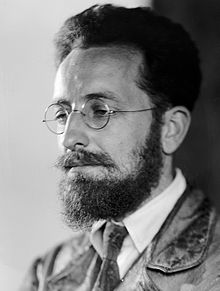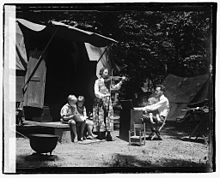Charles Seeger
Charles Louis Seeger (born December 14, 1886 in Mexico City , † February 7, 1979 in Bridgewater , Connecticut ) was an American musicologist and composer .
Life
The eldest son of the Mexican entrepreneur Charles Seeger sen. and his wife Elsie Simmons Adams (* 1861 ) came to his home country in 1887 when his father bought a villa for the family on Staten Island . In the following years, however, the family spent several longer periods (from 1892 and from 1900) in Mexico. From 1902 Seeger attended the Hackley School in Tarrytown , New York State, and from 1904 to 1908 Harvard University .
In the autumn of 1908 Seeger traveled to Europe. After several weeks in Munich , he took up a position on January 1, 1909, as assistant to the director of the Cologne Opera , Otto Lohse . After two years, however, he found that he would not be able to take up the desired profession of conductor because of his poor hearing, and so he turned to composition and musicology. According to his own statements, it was initially his goal to compose the first major American opera. Seeger was particularly influenced by the contemporary French composer Erik Satie .
In the spring of 1911 Seeger returned to New York to devote himself to composition. At the same time, the revolution that broke out in Mexico forced his family to flee. His father, who last worked as the (first) automobile importer in Mexico, began a new existence, first in Havana , then in Europe, as a businessman in the service of the American Rubber Company.
Six weeks after his arrival in New York, Seeger met the violinist Constance de Clyver Edson (* 1886, † 1975), who initially only became his musical partner, but whom he was able to marry in New York on December 22, 1911 after she had made some money through concerts and lessons. The couple had three children, Charles III. (* September 16, 1912, † August 26, 2002), John (* February 16, 1914, † 2010) and Peter known as Pete Seeger (* May 3, 1919 † January 27, 2014).
Six months after his marriage, in May 1912, Seeger got a job as professor of music at the University of California in Los Angeles , during which he built up the musicology faculty at his university, and which he led until 1919. During his time in California, Seeger developed a social awareness, shaped by the raging revolution in neighboring Mexico, the numerous impoverished migrant workers in California and the First World War that broke out in Europe . His advocacy for the concerns of the lower class and his pacifist convictions, which were strengthened by the death of his brother Alan (July 4, 1916 near Belloy-en-Santerre, born June 22, 1888 in New York) as a foreign legionary in World War I, prepared him increasing problems in the social environment.
Seeger moved to Patterson , New York State, on a research leave in October 1918 . His social problems have now been supplemented by professional doubts, which shortly afterwards culminated in a nervous breakdown. Consequently, in 1919, he decided not to return to California.
In November 1920, the family, now with three sons, gave up their place of residence and set out on a journey through the country with a self-made caravan to introduce the rural population to classical European music. However, the necessary wintering in a caravan with a meager income led Seeger to give up the project the following spring. According to his son John, he was also somewhat disillusioned with the fact that the American people "don't need their music" because they themselves have a vibrant musical culture. The return journey to New York led via Washington, where Seeger, with the support of influential friends, including the wife of the new Vice President Coolidge , was able to give concerts which, through his brother-in-law, Elie Edson, who worked as a press agent, found widespread coverage in the local newspapers.
In August 1921, Seeger and his wife began a new career path when they became teachers at the Institute of Musical Art in New York (later the Juilliard School of Music ). He taught musicology, his wife Constance gave violin lessons. In the following years, however, this professional stability was offset by an increasing breakup of the family, which was followed by the final separation of Charles and Constance in 1929 and a divorce three years later. The divorce, his political activities and Seeger's growing interest in modern music damaged his reputation with his employer and were a reason for the loss of his job at the Institute of Musical Art in 1933.
On October 2, 1932 Seeger married his second wife Ruth Crawford Seeger (* July 3, 1901, † November 18, 1953), who was also a talented composer and pianist. The marriage resulted in the children Michael (born August 16, 1933 - August 7, 2009), Peggy (born June 17, 1935), Barbara Mona (born May 4, 1937) and Penny (born 1943).
In the winter of 1931 Seeger became a member of the Composer's Collective of New York , a community of left-wing musicians, to which Hanns Eisler (1934) and Aaron Copland also belonged for a time. In November 1935, Seeger left the group not only because of doubts about the content, but also because the government was watching it with suspicion and feared the personal consequences.
On June 3, 1934, he and other musicians founded the American Musicological Association (name later changed to American Musicological Society ), of which he became president in 1960.
After the death of his second wife in 1953, Seeger renewed a relationship with his childhood friend Margaret Adams Taylor, whom he married in March 1955, also because he wanted a "real" home for his three teenage daughters. However, the marriage ended in divorce at the end of 1960.
From 1957 Seeger taught at the University of California , since 1961 as a professor at the Institute of Ethnomusicology . He finally had to give up this position in 1971 because of his old age of 85. Charles Seeger, his sons Mike and especially Pete Seeger , who became a role model for numerous world-famous musicians, shaped the intellectual-political folk- culture music scene. His daughter Peggy Seeger has also become a well-known folk musician.
Finally Charles Seeger decided to return to New England, where he lived with his sister Elizabeth († 1973) in Bridgewater, Connecticut, in the house that his grandfather Edwin Seeger had bought a century earlier. In 1973 he was elected a member of the American Academy of Arts and Sciences .
literature
- Bell Young and Helen Rees: Understanding Charles Seeger, Pioneer in American Musicology . ISBN 0-252-02493-1 .
- Ann M. Pescatello: Charles Seeger: A Life in American Music . Pittsburgh, 1992. ISBN 0-8229-3713-1 .
- Malik Sharif: Speech about Music. Charles Seeger's Meta-Musicology . Hollitzer, Vienna 2019, ISBN 978-3-99012-559-5 .
Web links
Individual evidence
- ^ Charles L. Seeger - radio astronomer, pioneer SETI scientist , obituary on SFGate, September 14, 2002
- ↑ "How Can I Keep from Singing." A Seeger Family Tribute at the Library of Congress. , American Folklife Center News Vol. 28: 4, Fall 2006, Library of Congress (English, PDF)
- ^ David K. Dunaway: Charles Seeger and Carl Sands: The Composers' Collective Years. In: Ethnomusicology, Vol. 24: 2, 1980, pp. 159–168 (preview at JSTOR )
| personal data | |
|---|---|
| SURNAME | Seeger, Charles |
| ALTERNATIVE NAMES | Seeger, Charles Louis (full name) |
| BRIEF DESCRIPTION | American musicologist and composer |
| DATE OF BIRTH | December 14, 1886 |
| PLACE OF BIRTH | Mexico city |
| DATE OF DEATH | 7th February 1979 |
| Place of death | Bridgewater , Connecticut |

